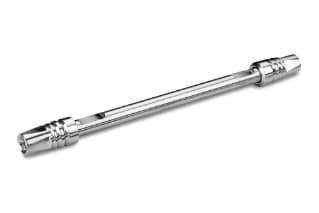
|
Chemistry |
PFP/Fluoro-Phenyl |
|
Separation Mode |
Reversed Phase |
|
Particle Substrate |
Hybrid |
|
pH Range Min |
1 pH |
|
pH Range Max |
8 pH |
|
Maximum Pressure |
18000 psi (1240 Bar) |
|
Endcapped |
No |
|
Bonding Technology |
Fluoro-Phenyl |
|
Silanol Activity |
Low |
|
Particle Shape |
Spherical |
|
Particle Size |
1.7 µm |
|
Endfitting Type |
Parker-style |
|
Pore Size |
130 Å |
|
Format |
Column |
|
Surface Area |
185 |
|
System |
UPLC, UHPLC |
|
Particle Technology |
CSH |
|
USP Classification |
L43 |
|
Inner Diameter |
2.1 mm |
|
Length |
100 mm |
|
Carbon Load |
10 % |
|
eCord |
Yes |
|
UNSPSC |
41115709 |
|
Brand |
ACQUITY UPLC |
|
Product Type |
Columns |
|
Units per Package |
3 pk |

ACQUITY UPLC CSH Fluoro-Phenyl Column, 130Å, 1.7 µm, 2.1 mm X 100 mm, 3/pk
The ACQUITY CSH Fluoro-Phenyl column is designed to increase selectivity differences and gives maximal method development freedom, especially when utilizing low pH mobile phases. The non-end-capped sorbent improves the retention of acidic chemicals.
The CSH Fluoro-Phenyl combination, with the specific benefit and combination of Charged Surface Hybrid (CSH) particle technology, aids in offering increased retention of acidic chemicals when compared to typical PFP-bonded stationary phases. It will offer distinct column selectivity as well as reproducibility. CSH Technology also contributes to the provision of remarkable peak shape and loading capacity for basic chemicals at low and high pH without the use of ion-pair reagents, as well as the system's exceptional stability at low and high pH.
Add the ACQUITY UPLC CSH Fluoro-Phenyl Column to your setup to execute experiments easily and confidently. The ACQUITY UPLC CSH Fluoro-Phenyl Column can readily function within a pH range of 1 to 8 and can withstand up to 18000 psi (or 1240 Bar). The ACQUITY UPLC CSH Fluoro-Phenyl Column has a pore size of 130Å and can accommodate a carbon load of 10%.
Waters assures that only the highest quality measures and strictest conditions are utilized in the manufacturing of the ACQUITY UPLC CSH Fluoro-Phenyl Column, giving you peace of mind that the lab equipment will not need to be replaced frequently and will provide consistent and accurate results. You can shop for lab equipment on our website based on your laboratory requirements.
You may also be interested in Neutrals QC Reference Material, which is suited for use with any chromatographic system that includes a UV detector. Its purpose is to serve as a system benchmarking standard. The mixture exclusively comprises neutral chemicals. The QC Reference Material, when used consistently and control documented, will provide confidence in your results, decrease troubleshooting and re-run time, and enable cross-laboratory result comparisons. This reference material can be used with a wide range of separation procedures.
What Are The Best Techniques For Isolating And Cleaning Analytes?
To isolate and purify specific components of interest from a sample, two common solid-phase extraction (SPE) techniques are employed. When the concentrations of target chemicals are insufficient for precise quantification, the retention-cleanup-elution approach is commonly utilized. This method enables the concentration of diluted samples and the enrichment of trace chemicals. Alternatively, when the desired sample component is already present at a high concentration, a pass-through cleanup method can be employed. However, it is important to note that the pass-through cleanup approach does not result in sample enrichment.